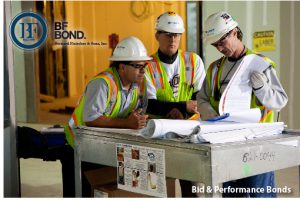
Question: What is the process needed to apply for a Bid & Performance bond?
Upon contacting us, an application will be sent, which will give the necessary information for the underwriter to know who you are and where you are coming from. It is impossible to give too much information regarding a contractor. Everything the contractor does should be given to the company. His ability as an estimator can be determined by sending the company the list of bids submitted on all bids. Newspaper accounts of work, pictures are always helpful.
The following outline should be followed in the submission of the first contract bond, or with the first filing of the financial statement; how is the contractor fitted for his business?
1. How old is he?
2. How long has he been in business?
3. What kind of work has he specialized in?
4. List the three largest contracts he has completed since he has been in business for himself.
5. Is he a careful estimator? A) Does he do his own estimating, or does he have an estimator? If so, give the estimator’s experience. B) Who checks these estimates?
6. Does he keep careful accounts, does he keep his own books, does his wife do it, or does he have an experienced bookkeeper?
Question: What are contractor’s financial resources?
1.Obtain a full financial, personal and business. See that it is dated.
2. Verify statement with the bank; see if the average bank balance
over a period of six months or a year approximates that shown
in the statement and if it varies greatly, why?
3. Stocks and bonds should be listed and described specifically, so
their value can be ascertained from market quotations.
(a) Any unlisted securities should be given special treatment, so
that the underwriter will be able to give them full value in
estimating the contractor’s true net worth.
(b)If any security is pledge as collateral, this fact must be noted
in the underwriting memorandum accompanying the
statement.
4. List each account receivable separately. The name of the debtor
should be given and the date when it is due or in the event it is
overdue, the date it is expected to be paid. Any receivable that is
withheld until completion of work, or during a maintenance
period, should be noted, giving the dates that the money’s are to
be released to the contractor.
5. The inventory should be divided into two classes:
(a) That part of the inventory that can be used in the contract
under consideration. This is a quick asset.
(b) All other material that does not have a ready market should be considered as a fixed ( or slow ) asset
6. Real estate should be described fully, stating the kind of
improvements, whether farm land, subdivision, city
lots, buildings, dwellings. If the property produces an
income, amount should be stated. Often the contractor owns
property jointly with a spouse or has real estate in the spouse’s
name. If incorporated, corporate asset, such conditions dictate
indemnity of spouses needed.
7. List all of the larger pieces of the contractor’s equipment. Give
type, model, & capacity of each piece. Advise cost, date of
purchase, present value. If the contractor rents special
equipment, ascertain from whom he will rent, per deim of
equipment.
These help the balance sheet and make the Bid & Performance bond easier to obtain.
For more information about Bid & Performance Bonds visit us at www.bfbond.com, or call 1.800.921.1008
